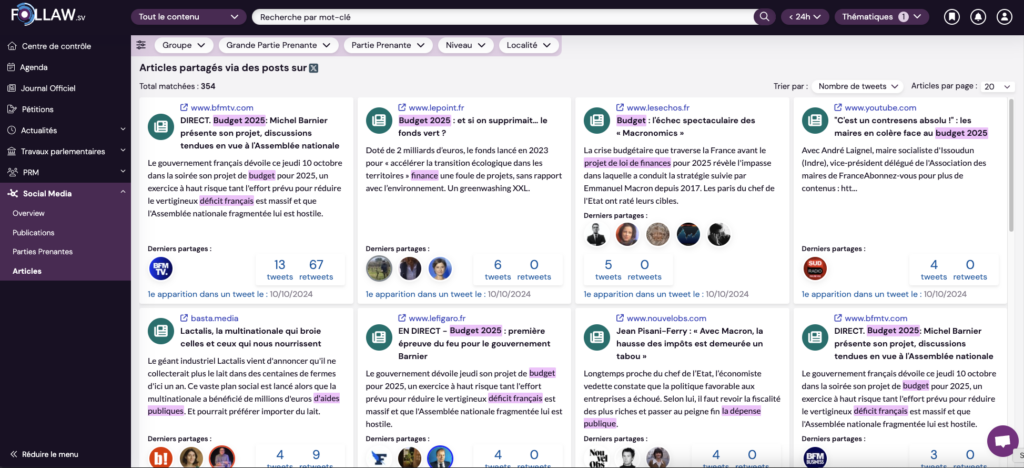Sommaire
Which lobbies are best placed to influence the new government on social networks? The case of the PLF 2025
The drafting of the Finance Bill (PLF) for 2025 is already generating intense activity in the media. And with good reason: many sectors and businesses are likely to be affected. Which ones have a card to play on social networks? What are the best media to reach them on Instagram or X? To find out, we have reconstructed the ecosystem of ministers' social network followings.
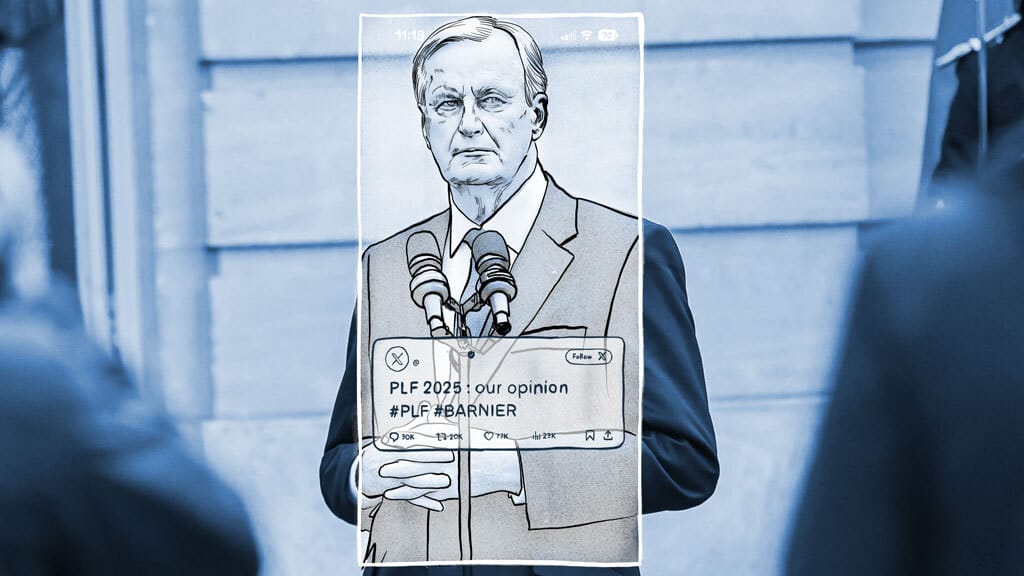
The summary
- The first key is that social networks will be less important than with previous governments. Our methodology, based on the following practices of ministers, seems rather far removed from current realities. This is due to X, which has been scaring politicians and lobbies ever since Musk took control. But also the fact that the following practice is no longer so important for those who take over the communication of politicians.
- Let's also be diplomatic: the ministers in the new government are also very old school. It's hard to imagine a minister turning on his phone to read X or Instagram. And with good reason: some ministers hardly ever had a single article in the press before their term of office. It's a far cry from the Tik Tok presence of the previous government.
- Does this mean that social networks will have no influence? For that to happen, we will either need to see changes in technical usage, or rely on the fact that government departments have social network monitoring systems in place. However, this seems obvious given that lobbies have evolved with practices and are now only present in these areas. The fact that the PLF has, as usual, leaked the draft in context shows once again that the government still needs to listen to the lobbies!
- Instagram's place for certain political pleas for left-wing NGOs and associations is difficult to understand insofar as on Instagram, ministers only follow other politicians and the absence of an API can mean that they miss their pleas.
- French tech and influencers far less present : As a corollary of the more old-fashioned and less new-world ministers, the influence of French Tech is less, as it is for certain political analysts such as Hugo Travers (Hugo Decrypte), who is ranked ... 1460th place. That's quite a change from before!
- A much stronger local and territorial presence: Another strong observation when looking at the differences with previous governments is the fact that local and territorial bodies have a much stronger presence. The AMF (and even the Association des maires ruraux de France, the Association des Maires de France) is one of the most closely followed, while the "Régions de France", "Intercommunalités", "Union des entreprises de proximité", "IFRAP" and other associations of local and regional authorities are also well represented.
- Lobbies followed by ministers around 3 networks:
- The agricultural networks with the young farmers, who have always been very active in lobbying. (One of the few lobbies that had RN/LR amendments published as a result of their drafting). Lastly, Brasseurs de France seems to be the anomalous lobby of the lot, but a look at the federation's past organisation chart will help you understand that a former managing director helped it to be well positioned numerically.
- The economic networks of local and intermediary companies. The local economy, ranging from small businesses to ETIS (with METI well positioned), is the second most closely followed lobby with general clauses.
- Finally, a societal ecosystem with general lobbies, but with strong influence from the CRIF and LICRA (so it's no coincidence that Michel Barnier attended the CRIF evening).
Methodology
We looked at all the ministers' social networks and those they followed. Using our panel, we selected the main lobbies or people who had worked for lobbies. We merged the accounts of the different social networks according to their nickname or name to cover all the potential links. Of course, the supposed influence of a lobby, journalist or media presupposes that the minister or his entourage is influenced by the network he follows on social networks. The fact remains that, in general, following on networks is correlated with activity or interest in them.
I. The 360 social media ecosystem of influence
By mapping the follow-ups of the various ministers (these are the only links displayed in the image), showing here only the lobbies (what we call labels, i.e. what is written) and assigning the size according to the actors with the most follow-ups. Interesting, we don't really distinguish any particular communities.
At most, the community in ochre green is the community of accounts on Instagram that have far less influence on ministers than on X. So that's the first thing we can learn: while ministers may have a presence on Instagram, they follow very few social networks.
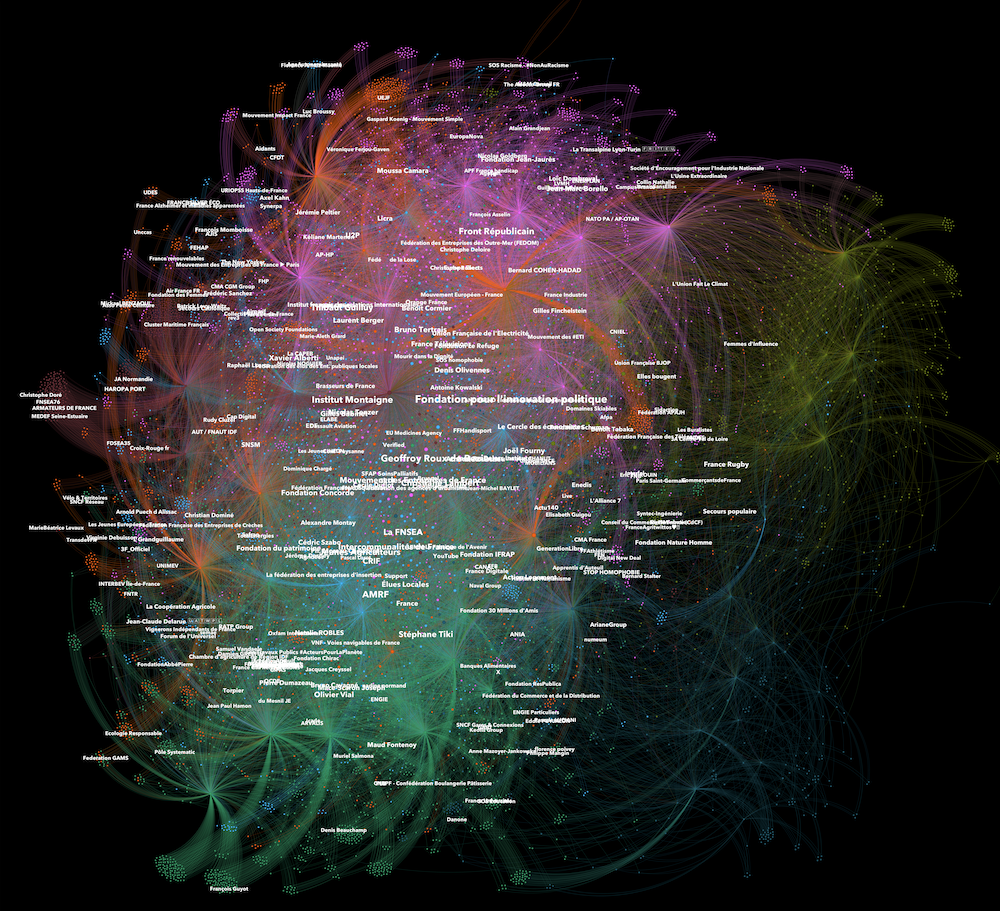
This is confirmed by the fact that while ministers follow no fewer than 9770 different accounts on X, they are only 1454 different unique people on Instagram. The vast majority of these are other politicians.
Basically, we follow each other among political friends or colleagues. But there's none of the media logic and influence of X on Instagram. The communities (symbolised by the colours) are quite clear: at the bottom of the graph you can see a very light LR community, while at the top of the graph it's the EPR axis.
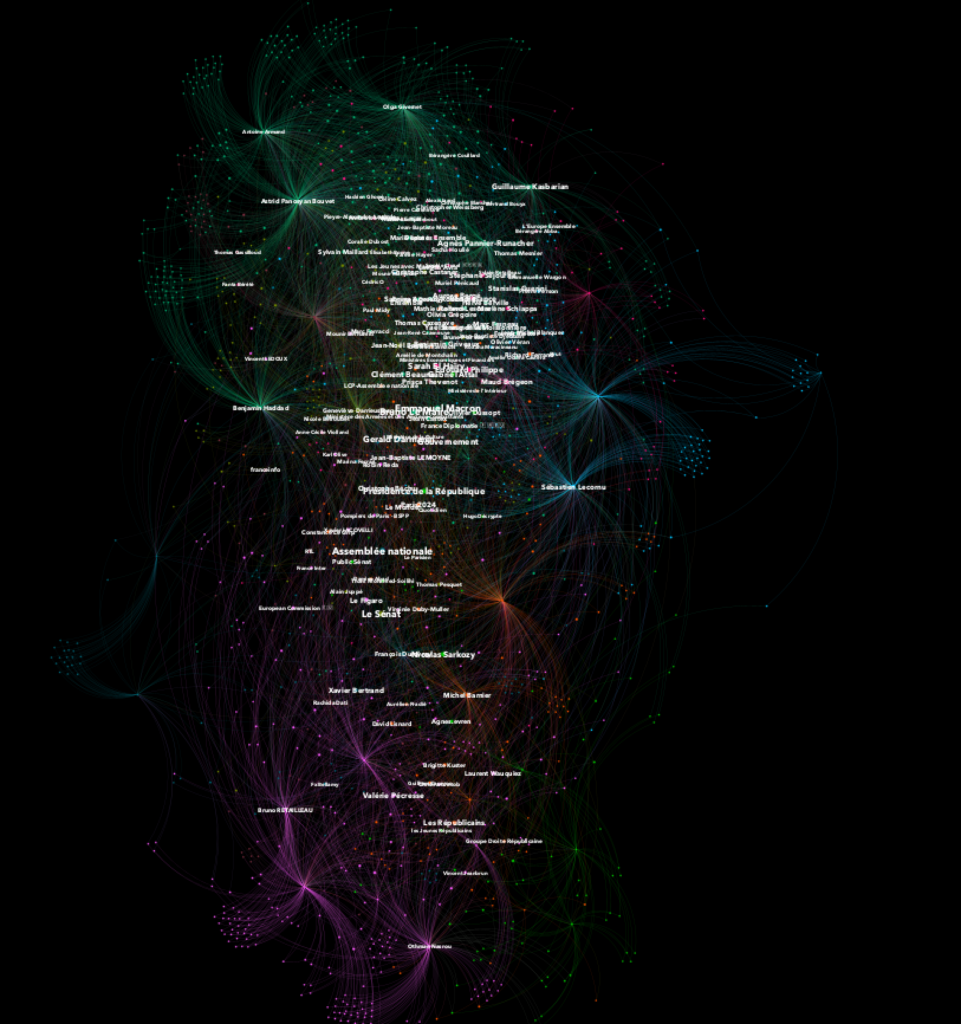
II. In terms of media, influence should be on X, Instagram and "centrist" media
Then, by analysing each minister individually, we can quickly see that the ministers' presence on the networks is highly localised. There is no general presence on TikTok, Bluesky or Threads, while 39 ministers are on X and 35 are on Instagram. And a third are on LinkedIn, where it is difficult to analyse their relational network apart from their liking and sharing activities.
In the media they follow the most, we find media relatively in the centre of the spectrum, whereas we might have expected an over-representation of right-wing media (Le Figaro in the lead, which is only 6th).
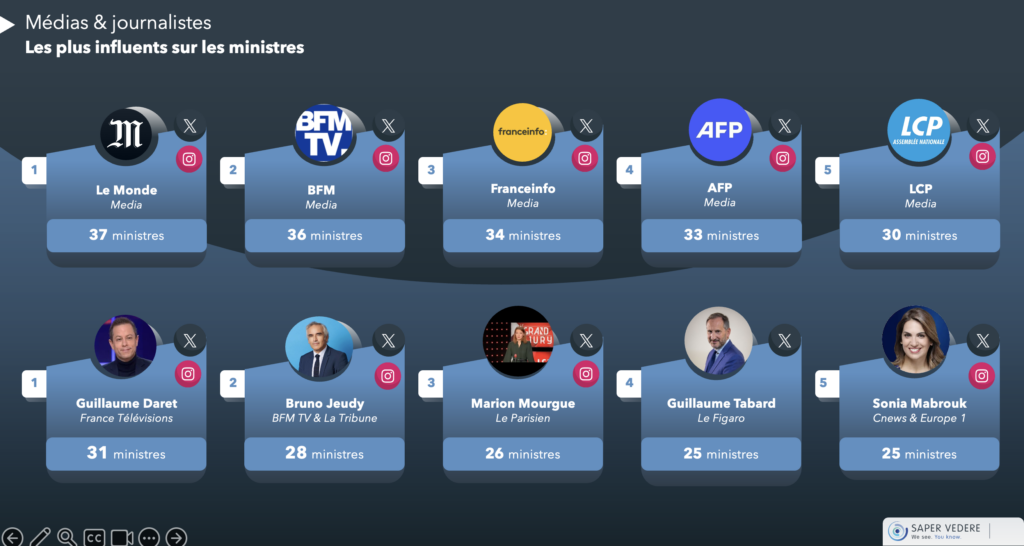
It is mainly political commentators and interviewers who stand out in terms of their influence on social networks, as the next in line behind the top 5 are : Jean-Michel Aphatie, Apolline de Malherbe, Ludovic Vigogne, Renaud Pila and Jean-Jacques Bourdin.
As a corollary of the older ministers, all the new media and some political analysts affecting younger populations are very low. For example, Hugo Travers (Hugo Decrypte) is ... 1460th place. (Although he is undoubtedly one of the most influential on Instagram, along with Brut).
III. THE LOBBIES Lobbies
Analysis of lobbies
The ecosystem of lobbies most closely followed by the government is as follows:
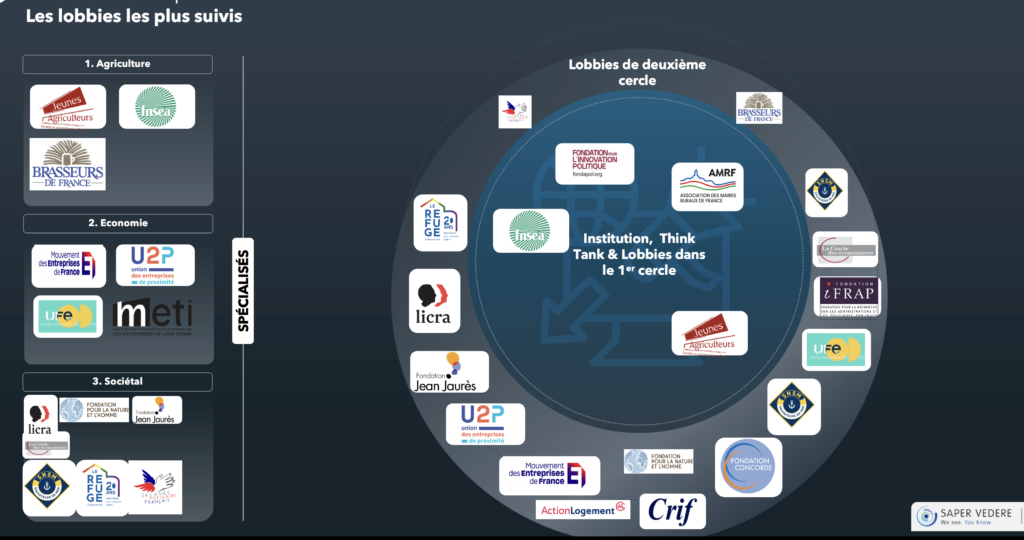
There are 3 main areas of focus:
- The agricultural networks with the young farmers, who have always had a very remote lobbying practice. (One of the few lobbies that had RN/LR amendments published as a result of their drafting) Finally, Brasseurs de France seems to be the anomalous lobby of the lot, but a look at its past organisation chart helps us to understand that a former general manager close to Barnier's networks helped it to be well positioned numerically.
- Local and intermediate business networks. The local economy, ranging from small businesses to ETIS (with METI very well positioned), is the second most closely followed sector of interest grouping.
- Finally, a societal ecosystem with societal lobbies, but with strong influence from the CRIF and LICRA (so it's no coincidence that Michel Barnier attended the CRIF evening).
Apart from that, we find a relatively highly political ecosystem with former politicians who have a very good audience with the current government. For example, Marlène Schiappa, who now works for Tilder, is taking advantage of her previous account to be very well positioned for her speeches. A glance at her X presence shows that she doesn't really use it, however.
But even generally speaking, the social media influence of ministers remains very much confined to certain sectors that have already been identified. (Sectors such as health, automotive, aviation and energy are completely absent from this ecosystem.
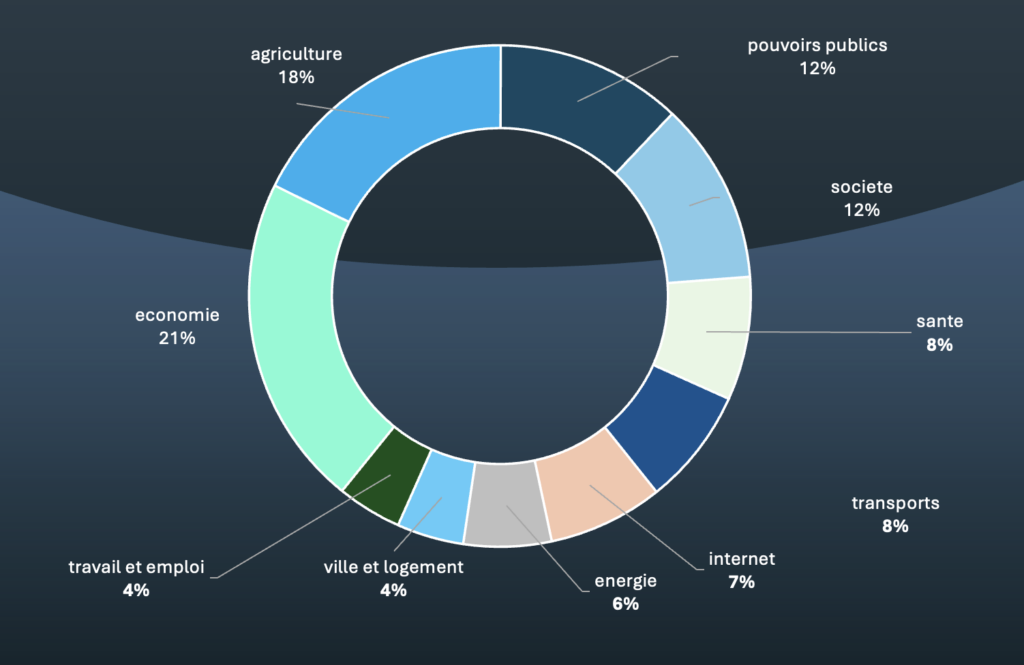
Using this data, we can identify a correlation between the sectors that will lose out most from the PLF 2025, namely business aviation, healthcare, energy, sea freight, insurers/banks and the automotive sector.
The PLF is completely unclear
There are three worlds in the world of societal influence: the world of politics, the world of interest groups and "the French".
All three are in a state of extreme uncertainty as the PLF approaches, with the political world at a loss as to what strategy to adopt, having a relatively short long-term deadline (the presidential election) and a relatively long short-term deadline (June 2025); the world of the 'French' who, after a summer break over the Olympics, find themselves with a 'slight' budgetary gap of 100 billion; and finally the interest groups who don't really know which way to go,
bewildered in their short-termist vision of things, wondering how less than 50 MPs can have so much influence. (For a world used to trying to act in 3 weeks on a bill, this is obviously a shock).
Faced with these uncertainties on all 3 fronts, it's hard to be objective. So we need to adapt quickly!
On the budget, awaiting the PLF
As far as interest groups are concerned, it has been very difficult to react quickly. And it shows (see our study last week): only left-wing associations such as Oxfam, Attac, Unapei, interest groups involved in the ecological transition (construction, automotive) or health (LEEM) as well as trade unions have already published. In one month, the number of publications is microscopic. (just 744 publications, retweets and all networks combined....)
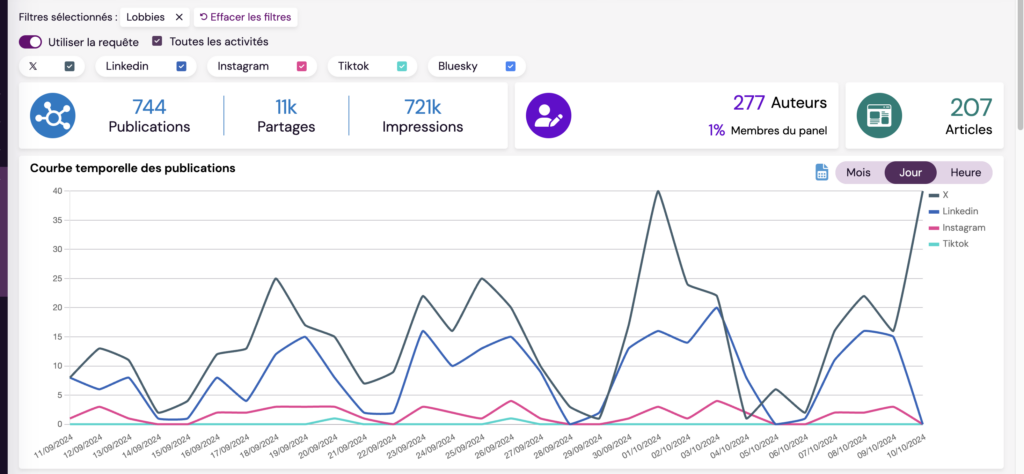
This is highly unusual:
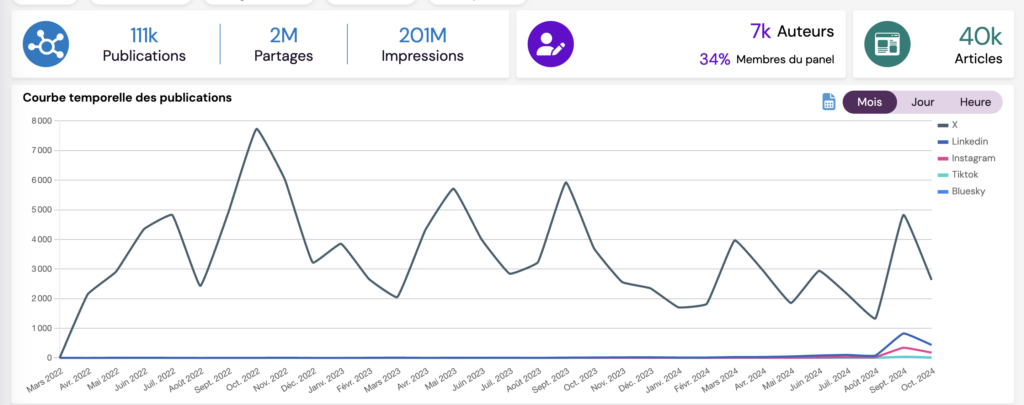
That leaves a large number of interest groups who will be reading the PLF released yesterday afternoon to take a stand and try to influence things. So it's going to be very interesting to see the amendments, the publications and all the influence with the only possibility of doing it in real time.
In any case, the fact remains that very few of them can say that they now have the assets, the methods and the strategy needed to pre-empt the social networks in order to get the government's initial plan moving.
And by registering for free with Follaw.sv, you'll be able to follow all the action surrounding the Finance Act.
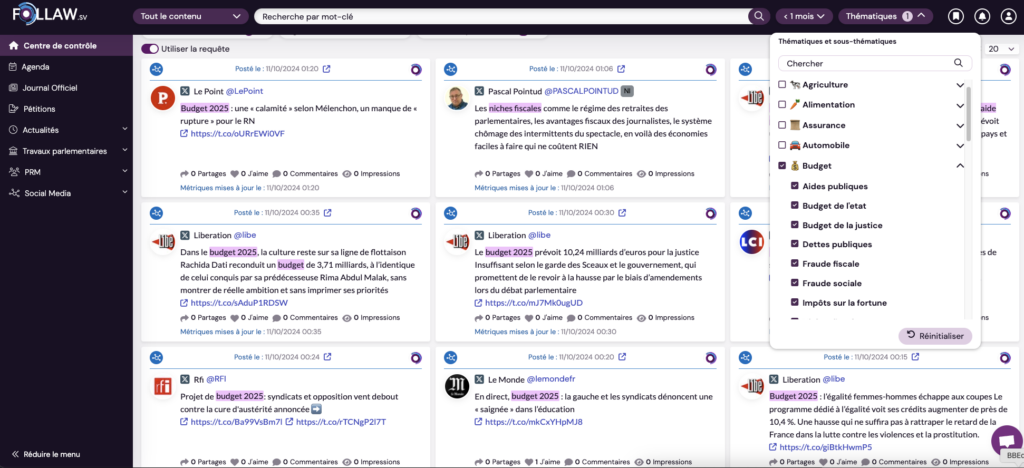
So follow all the amendments, all the articles and all the budget publications by joining the democratisation of public affairs.
